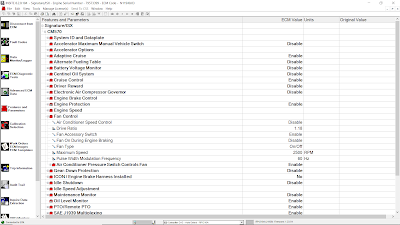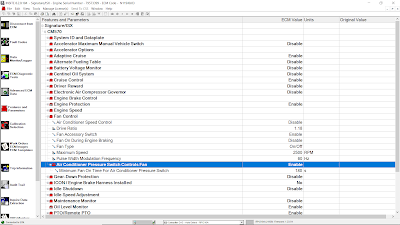Fan Control on Cummins INSITE Software (CUMMINS Engines)
Fan Control

#Feature Description
This feature controls an OEM supplied fan that is installed to meet the needs of vehicle and engine systems that rely on fan cooling for proper operation. This feature enables the ECM to turn the fan on or off in response to any of the following inputs:
Engine operating conditions (coolant temperature, intake manifold temperature, etc.)
Fan overspeed control
Air conditioner operation
Manual fan switch
Engine performance requirements, such as engine braking
Vehicle speed
#Adjustable Parameters
Fan Control – When enabled, this allows the user to set up the parameters for proper engine cooling, reducing intake manifold temperature, air conditioner refrigerant temperature, and aiding in engine braking.
Fan Control Logic – When the “Fan Control” is enabled, this parameter will allow the user to set logic of the fan voltage.
-0 Volt On — The fan will turn ON at 0 volts and turn OFF at 12/24 volts.
-12/24 Volt On — The fan will turn ON at 12/24 volts and turn OFF at 0 volts.
Air Conditioner Pressure Switch Input – Enables the ECM to respond to an air conditioner pressure switch installed by the vehicle manufacturer. The ECM will turn on the fan in response to signals from the air conditioner pressure switch.
Minimum Fan On Time for Air Conditioner Pressure Switch – The minimum time that the fan will operate in response to the air conditioner pressure switch. This parameter can reduce fan cycling.

Vehicle Speed Interaction – When enabled and the vehicle is stationary or at a low speed, when the air conditioning causes the fan to run, it will run continuously. The fan will continue to run until the vehicle exceeds a predefined calibrated vehicle speed threshold or the engine is shut down and restarted.
Fan Control Switch – When enabled, the ECM will respond to a manual fan switch installed in the cab by the vehicle manufacturer. The operator may turn the fan on regardless of operating conditions.
Air Conditioner Speed Control – This feature enables the fan to run continuously during idle with the air conditioner on. If this feature is enabled and the air conditioner pressure switch causes the fan to turn on, the fan will remain engaged until vehicle speed exceeds 6 miles per hour. When the vehicle speed is above 6 miles per hour, the fan will run for at least the time specified by Minimum Fan On Time for Air Conditioner Pressure Switch.
Fan On During Engine Braking – If enabled, the ECM turns on the fan with the engine brakes. This is typically calibrated to occur with extended brake operation only; for example, some calibrations will activate the fan if the engine brakes are held on for more than 15 seconds. This feature provides extra parasitic load during periods of extended engine braking. Heavy-duty engines include a built-in delay that causes the fan to turn on after the engine brakes are activated.
Fan Minimum Run Time – When enabled, the Minimum Run Time can be configured. This parameter is set by the calibration.
Minimum Run Time – This is the minimum time the fan will run when ON.
Fan On with Remote Throttle – When enabled, this will allow the fan to turn on when the remote throttle is in use.
Fan Type – The ECM sends a signal to the fan actuator according to the type of fan selected:
On/Off – also called “two-speed” fans; most ECM-controlled fans are this type. Many of these fans have an air-actuated clutch that is either completely engaged or completely disengaged.
Variable Speed – Varies the speed as required to attain lowest noise and power loss.
Variable Speed Fan Frequency – The frequency required by a variable speed fan. This value should be supplied by the vehicle manufacturer.
Tri-State – also called a “three-speed” fan. It runs at a low speed when possible, for lower noise and power loss.
Electronic Viscous without Speed Sensor – When the air temperature reaches a specific level, the control moves an actuator that allows viscous fluid to engage the fan drive and increase the fan speed. The Pulse Width Modulation fan control signal from the ECM is used to control the fan speed.
Electronic Viscous with Speed Sensor – When the air temperature reaches a specific level, the control moves an actuator that allows viscous fluid to engage the fan drive and increase the fan speed. The fan speed sensor provides speed feedback to more accurately control the speed of the fan.
Variable Speed without Speed Sensor – The Pulse Width Modulation fan control signal from the ECM is used to control and vary the speed.
Datalink Output – this will allow the ECM to accept input from a multiplexed signal.
High Efficiency Viscous – The Pulse Width Modulation fan control signal from the ECM is used to control and vary the speed at higher frequencies.
Drive Ratio – The ratio of the fan pulley revolutions to crankshaft pulley revolutions. For example a Drive Ratio of 1.2 indicates a fan pulley that is smaller than the crankshaft pulley, resulting in 1.2 fan revolutions for every crankshaft revolution. The Drive Ratio enables the ECM to calculate fan speed and turn the fan off if the maximum fan speed is exceeded (refer to the vehicle manufacturer or fan manufacturer recommendations).
Maximum Fan Speed – The ECM prevents the fan from running above this speed, which is defined by the vehicle manufacturer (refer to the vehicle manufacturer or fan manufacturer recommendations). The correct fan “Drive Ratio” must be entered for this parameter to function properly.
PWM Frequency – The pulse width modulation frequency required by a variable speed fan. This value should be supplied by the vehicle manufacturer.
OEM Pressure Input – When enabled, the fan speed will be controlled by the OEM pressure sensor.
OEM Temperature Input – When enabled, the fan speed will be controlled by the OEM temperature sensor.
#Special Instructions
The following special instructions apply:
When troubleshooting a fan that won’t turn on, first ensure that the correct type fan is selected.
Most heavy-duty trucks use On/Off air-actuated fans.
Many buses and RVs use hydraulically driven fans that are not controlled by the ECM.
Verify system wiring.
Does the fan clutch require 12 Volts or 0 Volts to turn ON?
Is the ECM fan clutch driver wired directly to the fan clutch or is there a relay in between?
If the fan is on all the time, ensure that the OEM-installed air conditioner pressure switch or manual fan switch has not failed.
Ensure that the OEM-installed fan clutch solenoid is grounded. If the solenoid grounds through the body of the fan solenoid, it may be necessary to remove the solenoid and clean paint or corrosion from the mounting surface.
#Disadvantages
Due to heat rejection, the Fan On During Engine Braking feature may appear inconsistent to some vehicle operators. For example, consider a calibration that engages the fan 15 seconds after engine braking starts. It may be possible for the fan to sometimes turn on sooner in response to air intake temperatures, coolant temperatures, or the air conditioner pressure switch.